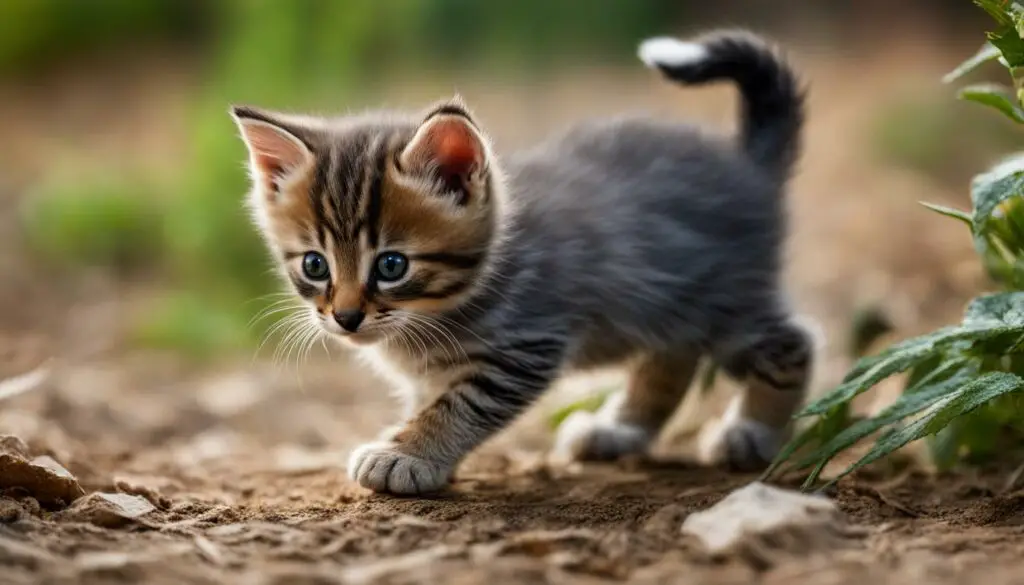Are you wondering why your adorable kitten keeps running away from you? It’s not uncommon for kittens to exhibit behaviors like running away when they feel scared, uncomfortable, or threatened. Understanding the reasons behind their actions can help you build a stronger bond with your furry friend and create a safe and loving environment.
In this article, I will explore the various factors that may contribute to a kitten running away and provide tips on how to prevent this behavior. Whether your kitten is scared, playful, or simply in need of some training, I’ll help you navigate the challenges and build a lasting relationship with your kitten.
Key Takeaways:
- Scared kittens may run away out of fear or discomfort.
- Playful kittens may run away as part of their natural instinct to explore and play.
- Training and socialization can help prevent kittens from running away.
- Bonding with your kitten through consistent interaction and positive experiences is essential.
- If your kitten has already run away, there are steps you can take to find them and bring them back home.
Why Do Cats Run Away From Their Owners?
It can be disheartening and concerning when your beloved feline companion starts running away from you. But why do cats exhibit this behavior? There are several reasons why a cat may run away from their owner, ranging from illness or injury to personality traits and mood.
Cats are known for their independent nature and strong prey instincts, which can contribute to their tendency to run away when they feel scared, uncomfortable, or threatened. This behavior can be seen in various situations, such as when a cat is not feeling well, experiencing stress or fear, or simply engaging in playful behavior.
Understanding the underlying reasons behind a cat’s running away behavior is crucial in strengthening the bond between a cat and its owner. By addressing any potential health issues, providing a secure and stimulating environment, and respecting a cat’s boundaries and preferences, cat owners can help alleviate their cat’s desire to run away and foster a trusting relationship.
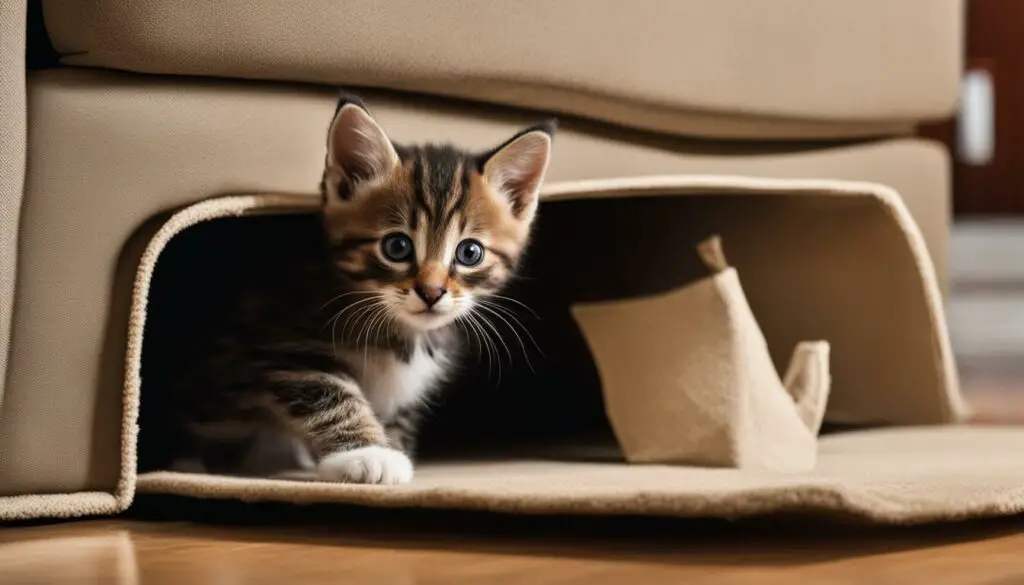
“Cats are known for their independent nature and strong prey instincts, which can contribute to their tendency to run away when they feel scared, uncomfortable, or threatened.”
Illness Or Injury
When a cat starts running away or avoiding their owner, it may be a sign of an underlying health issue that requires veterinary attention. Cats are experts at hiding signs of illness or injury, so it can be challenging to detect when something is wrong. However, if your cat is displaying unusual behavior such as running away, it’s important to consider the possibility of illness or injury.
Signs of illness in cats can vary depending on the specific condition, but some common indications include changes in eating or drinking habits, lethargy, hiding, vomiting, diarrhea, coughing, sneezing, and limping. If you notice any of these symptoms, it’s best to consult with a veterinarian for a proper diagnosis and treatment plan.
An injured cat may also be more likely to run away from their owner. Pain or discomfort can cause cats to seek solitude and avoid interactions. If you suspect your cat is injured, it’s important to handle them gently and seek veterinary care as soon as possible. Remember, cats are masters of disguise when it comes to pain, so it’s always better to be safe than sorry.
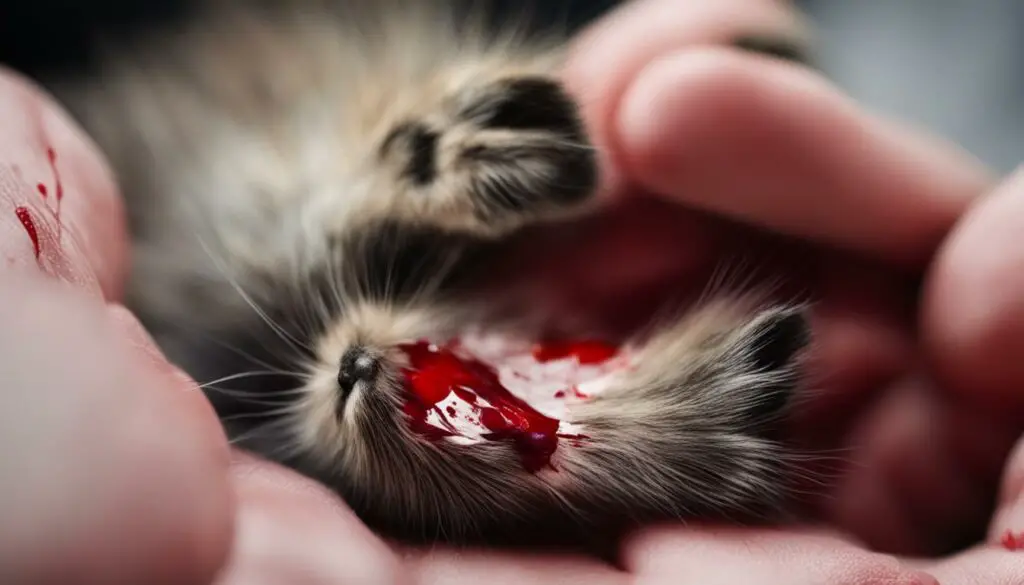
If your cat starts running away or behaving differently, it’s crucial to consider the possibility of underlying illness or injury. Cats are masters at hiding signs of pain, so it’s important to pay attention to any changes in their behavior or habits.”
Detecting Illness or Injury
It can be difficult to determine if your cat is ill or injured, but understanding their normal behavior and habits can help. Look out for any changes in appetite, litter box usage, grooming routines, or activity levels. Cats are creatures of habit, so any sudden deviations from their usual patterns may indicate a problem. Additionally, if your cat has been in an accident or experienced trauma, it’s important to seek immediate veterinary care, even if no visible injuries are present.
| Symptoms of Illness | Symptoms of Injury |
|---|---|
|
|
Remember, cats rely on their owners to advocate for their well-being. If your cat is running away or displaying unusual behavior, it’s essential to take their concerns seriously and seek professional veterinary advice. Prompt medical attention can help diagnose and address any underlying illnesses or injuries, ensuring your cat stays healthy and happy.
Stress or Fear in Cats
Cats can experience stress or fear in various situations, and these emotions can cause them to run away from their owners. It’s important for cat owners to recognize the signs of stress and fear in order to address these issues and create a safe and secure environment for their feline companions.
Some common signs of stress in cats include excessive grooming, hiding, aggression, changes in appetite, and inappropriate elimination. On the other hand, signs of fear may include flattened ears, dilated pupils, crouching or freezing, hissing or growling, and running away or hiding.
To help alleviate stress and fear in cats, it’s recommended to provide them with a quiet and comfortable space where they can retreat to when they feel overwhelmed. Additionally, ensuring a consistent routine, offering environmental enrichment through toys and scratching posts, and using positive reinforcement training methods can help reduce anxiety and build trust between the cat and its owner.
| Signs of Stress in Cats | Signs of Fear in Cats |
|---|---|
| Excessive grooming | Flattened ears |
| Hiding | Dilated pupils |
| Aggression | Crouching or freezing |
| Changes in appetite | Hissing or growling |
| Inappropriate elimination | Running away or hiding |
“Understanding a cat’s stress and fear cues is crucial in providing them with the support and care they need. By creating a calm and nurturing environment, cat owners can help their feline companions feel safer and prevent them from running away.”
Addressing Stress and Fear in Cats
When dealing with stress or fear in cats, it’s important to consult with a veterinarian or behavioral specialist to rule out any underlying medical conditions and to develop a comprehensive approach to managing these emotions. In some cases, medication may be prescribed to help alleviate anxiety in cats.
Additionally, positive reinforcement training can be used to help cats associate positive experiences with previously stressful situations. This can involve gradual desensitization to specific triggers and rewarding calm and relaxed behavior. Patience, consistency, and understanding are key when working with a stressed or fearful cat.
- Create a calm and safe space for the cat
- Stick to a consistent routine
- Provide environmental enrichment
- Use positive reinforcement training methods
- Consult with a veterinarian or behavioral specialist
By addressing and managing stress and fear in cats, cat owners can help their feline companions feel more secure and prevent them from running away. Building a strong and trusting bond with a cat is a gradual process, but with patience, love, and understanding, it is possible to create a harmonious and fulfilling relationship.
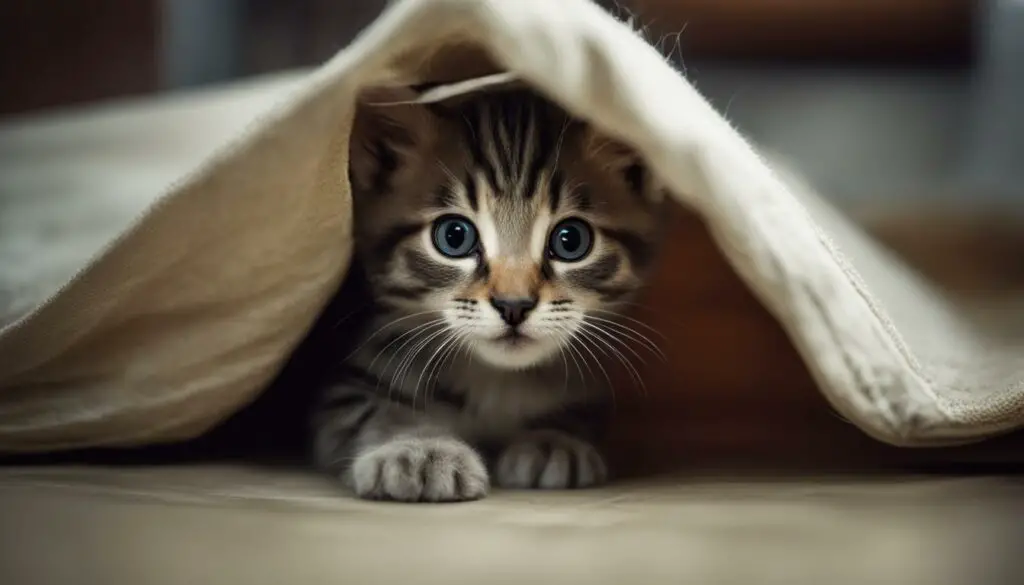
Social Interaction in Cats: Understanding Their Individual Behavior
When it comes to social interaction, cats have their unique personality traits and preferences. Just like humans, each cat has its own preferences for socializing and interacting with others. Understanding and respecting these individual differences are crucial for building a strong bond with your feline friend.
Some cats are naturally more outgoing and enjoy frequent and intense social interactions, while others may prefer shorter or lower-intensity interactions. It’s important to observe your cat’s body language and cues to determine their comfort level and preferences for social interaction. This can help ensure that you are providing them with the right amount and type of socialization.
Understanding Your Cat’s Social Interaction Preferences
There are a few key factors that can influence a cat’s social interaction preferences:
- Previous experiences: Cats that have had positive experiences with socialization from a young age may be more inclined to enjoy social interaction with humans and other animals.
- Genetics: Some cat breeds are known to be more sociable and enjoy human interaction, while others may be naturally more independent.
- Environmental factors: The environment in which a cat is raised can also play a role in their social interaction preferences. Cats that have been exposed to various stimuli, such as different people, animals, and environments, tend to be more adaptable and open to social interaction.
It’s important to remember that forcing social interaction on a cat that doesn’t enjoy it can cause stress and anxiety. Respect your cat’s boundaries and provide them with the opportunity to socialize at their own pace. This can help foster a trusting relationship and a positive social dynamic between you and your cat.
Cat Personality and Socialization
Just like humans, cats have their unique personalities. Some cats are naturally more extroverted and seek out social interaction, while others may be more introverted and prefer solitude. Recognizing and accepting your cat’s personality is essential for their overall well-being and contentment.
If your cat is more reserved and prefers quieter environments, providing them with a cozy and comfortable space where they can retreat to is important. On the other hand, if your cat enjoys social interaction, engaging in interactive play and spending quality time together can help strengthen your bond.
In conclusion, understanding and respecting your cat’s individual behavior and social interaction preferences is key to building a strong bond. By observing their body language, providing them with a safe and comfortable environment, and allowing them to socialize at their own pace, you can create a harmonious and fulfilling relationship with your feline companion.
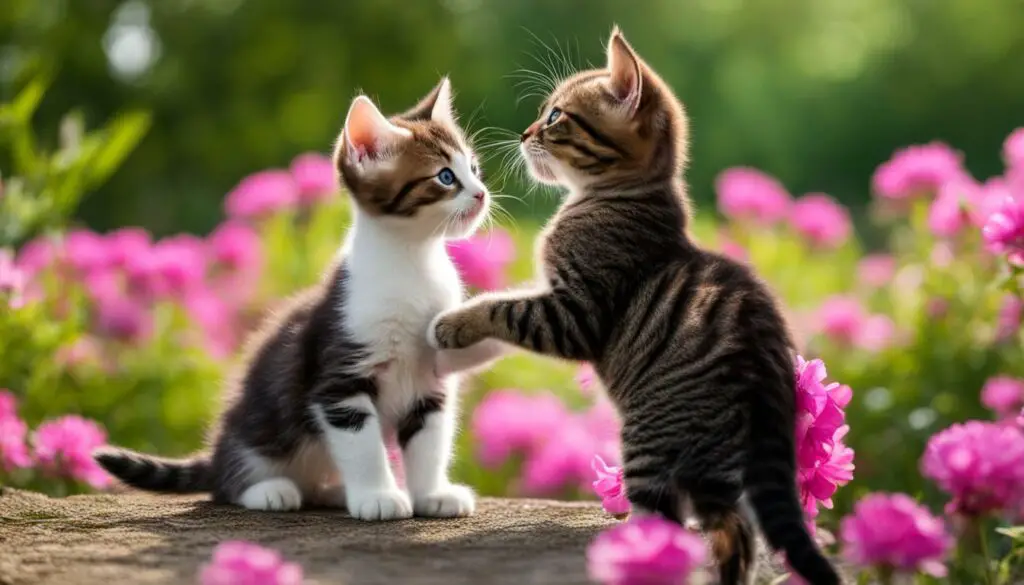
Cat Mood and Behavior: Understanding the Interplay
Understanding a cat’s mood is crucial for building a strong bond and preventing them from running away. Cats, like humans, have different moods that can influence their behavior and interactions. By being attuned to their mood, we can create a positive and enriching environment for our feline companions.
Cats are known for their independence and varying levels of sociability. Just like humans, they can experience different emotions, ranging from contentment and playfulness to fear and anxiety. These emotions can influence how they interact with their owners and other individuals, especially children.
When a cat is in a calm and relaxed mood, they may seek attention and enjoy gentle interactions with their human companions. However, if a cat is feeling stressed, anxious, or overwhelmed, they may exhibit behaviors such as hiding, hissing, or running away. It’s important to respect their boundaries during these times and provide a safe space for them to retreat to.
Mood-based behavior in cat interactions with children:
- Excited mood: A cat in an excited mood may be more prone to playfulness and may enjoy interactive play sessions with children. It’s important to supervise these interactions and ensure that children handle the cat gently.
- Fearful mood: If a cat is feeling fearful, they may be more likely to run away or hide from children. It’s crucial to teach children to approach cats calmly and gently, giving them the space they need.
- Relaxed mood: A relaxed cat is more likely to engage positively with children, allowing them to pet and interact with them. Encourage children to approach cats slowly and gently, letting the cat dictate the level of interaction.
By understanding a cat’s mood and behavior, we can create a harmonious environment that promotes positive interactions and minimizes the desire for a cat to run away. Building trust, providing enrichment, and respecting their individual needs are key in strengthening the bond between cats and their owners.
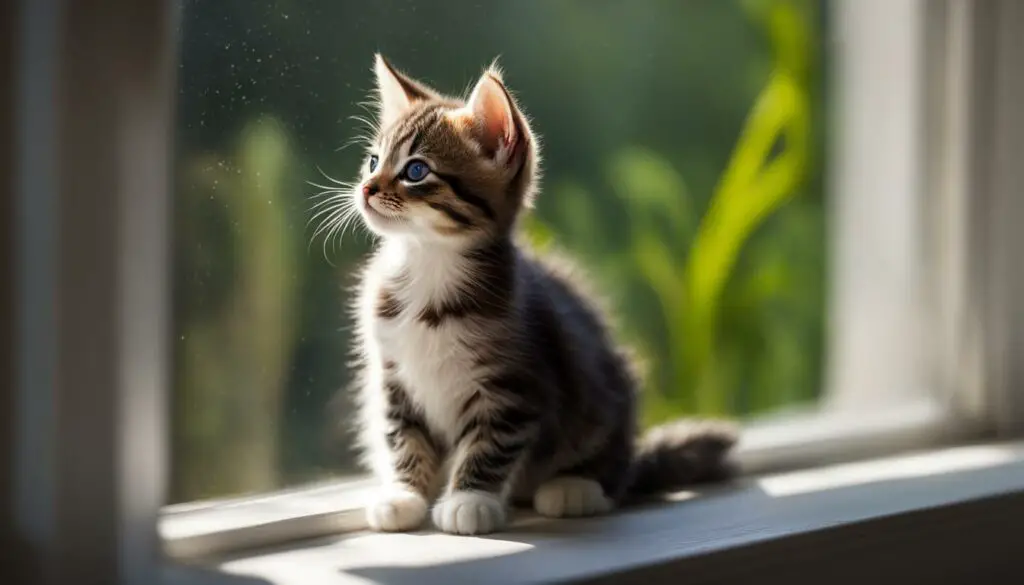
Playfulness
During playtime, cats can exhibit various behaviors, including running away as part of their playful nature. It’s important for cat owners to understand that running away during play does not necessarily indicate fear or avoidance. Instead, it can be a normal part of their interactive behavior. Cats may engage in a game of chase or hide-and-seek, running away to entice their owners to continue playing with them.
When cats run away during play, it is often accompanied by other playful behaviors such as pouncing, swatting, or chasing. They may dart behind furniture, climb to elevated surfaces, or hide in small spaces. This behavior is an expression of their natural hunting instincts and can also be a way for them to engage with their environment and release excess energy.
To encourage healthy play and prevent excessive running away, cat owners can provide interactive toys, such as feather wands or toy mice, that simulate prey-like movements. These toys can engage the cat’s hunting instinct and redirect their playfulness in a controlled manner. Incorporating regular play sessions into a cat’s routine can help satisfy their need for stimulation and reduce the desire to run away during playtime.
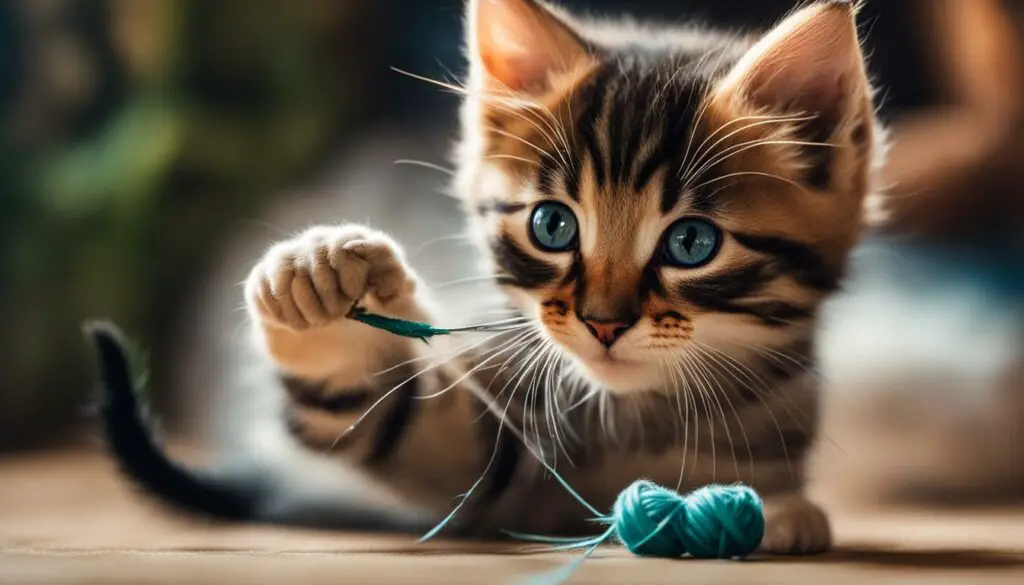
Remember, each cat has its own unique personality and play style. Some may prefer high-energy, active play, while others may enjoy more low-key, gentle play. It’s essential to observe your cat’s behaviors and adapt your play sessions accordingly. By providing appropriate outlets for their playfulness and understanding their individual needs, you can strengthen the bond between you and your cat.
Lack of Socialization
Socialization plays a crucial role in the development of a kitten’s behavior and their ability to form bonds with humans. During the critical period of a kitten’s life, typically between 3-7 weeks of age, they go through a sensitive phase known as the socialization window. This is when they are most receptive to new experiences and social interactions. If a kitten does not receive proper socialization during this time, it can lead to fearfulness and running away behavior in cats.
Forming a bond with a kitten starts with early handling and gentle interactions. Gradual exposure to different people and positive experiences can help them become more comfortable around humans. It’s important to respect their boundaries and allow them to approach you at their own pace. By providing a safe and nurturing environment during this critical period, you can help a kitten develop into a well-adjusted and sociable cat.

The Impact of Early Experiences
Kittens who have had limited exposure to a home environment, such as street cats or outdoor cats, may need extra patience and understanding when brought into a new home. The transition from their previous living conditions to a domestic setting can be overwhelming for them. They may display fear and stress by running away or hiding. Providing a calm and secure space for them to adjust, along with positive reinforcement and rewards for good behavior, can help them feel more at ease and less likely to run away.
“Proper socialization is crucial in building a strong bond with a kitten and ensuring their long-term happiness and well-being.”
Tips for Socializing and Bonding with a Kitten
- Start by creating a comfortable and safe space for the kitten in your home, including a cozy bed, litter box, and scratching post.
- Provide regular playtime sessions with interactive toys to stimulate their natural instincts and encourage positive interactions.
- Gradually introduce the kitten to new environments, sounds, and experiences to help them become more confident and adaptable.
- Offer treats, praise, and gentle strokes when the kitten displays desired behavior, reinforcing positive associations with human interaction.
- Give the kitten time and space to explore their surroundings at their own pace, allowing them to build trust and gradually become comfortable with their new environment.
Remember, each kitten is unique and may require different amounts of time and patience to socialize and form a bond. By understanding the importance of socialization and providing a nurturing environment, you can help your kitten grow into a confident and well-adjusted cat.
Lack of Experience
When it comes to cats, experience plays a significant role in their behavior and reactions. Cats that have had limited exposure to a home environment, such as street cats or outdoor cats, may experience fear and stress when brought into a new home. The unfamiliar surroundings, smells, and sounds can be overwhelming for them. This lack of experience can contribute to their desire to run away and find safety in what they know.
Adopting a cat with a background of living on the streets or in outdoor environments can present unique challenges. These cats may have never experienced the comforts and security of a home before. It’s important to approach their transition with patience and understanding, recognizing that they may need time to adjust.
Creating a safe and comfortable environment for a cat with limited experience is crucial. Providing them with a designated space where they feel secure, such as a quiet room with their litter box, food, and water, can help ease their anxiety. Gradually introducing them to other areas of the home and social interactions can also help them acclimate to their new surroundings.
| Challenges | Possible Solutions |
|---|---|
| Overwhelmed by unfamiliar surroundings | Provide a designated safe space and gradually introduce them to new areas |
| Limited experience with indoor environments | Patience and understanding during their transition |
| Adjustment to new sounds, smells, and routines | Establish a consistent routine and provide familiar scents and objects |
By offering a calm and predictable environment, along with plenty of love and reassurance, cats with limited experience can gradually feel more comfortable and secure in their new homes. It’s crucial to remember that each cat is unique and will require different amounts of time and support to adjust to their new surroundings. Patience and understanding are key in helping them overcome their lack of experience and build trust in their new environment.
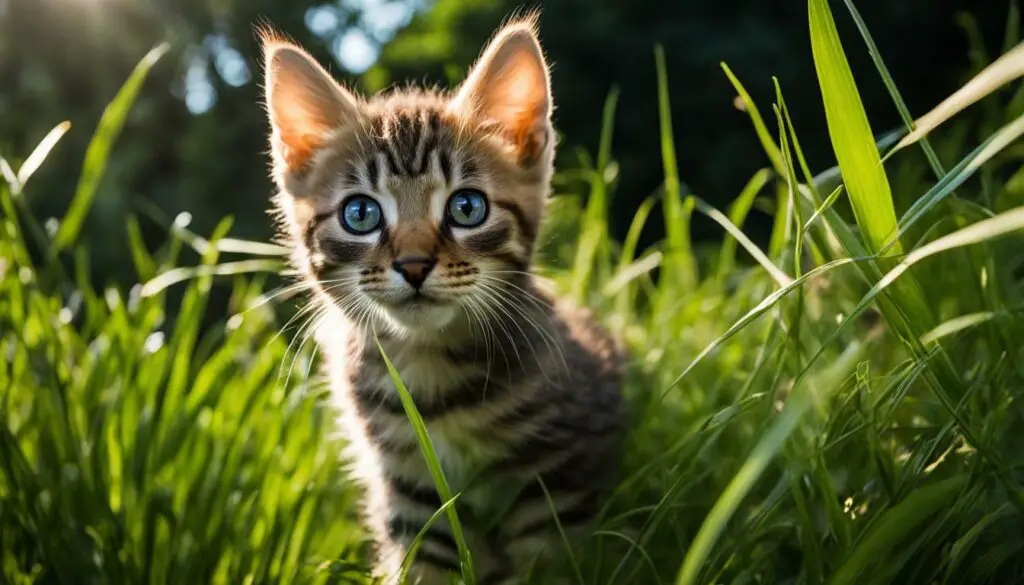
Genetics and Temperament
Understanding the role of genetics and temperament in a cat’s behavior is crucial for cat owners. Just like humans, cats inherit certain traits and tendencies from their parents, which can influence how they react to different situations. Genetic factors can contribute to a cat’s fearfulness and anxiety, making them more likely to run away from their owners.
It’s important to note that genetics is not the sole determinant of a cat’s behavior. Environmental factors, socialization, and individual experiences also play a significant role. However, genetics can provide valuable insights into understanding certain aspects of a cat’s temperament and behavior patterns.
Some cats may have a predisposition towards being more skittish or anxious due to their genetic makeup. For example, cats born to stressed mothers or in stressful environments may exhibit more fearful behavior as they grow up. This genetic predisposition does not mean that all cats with similar genetics will display the same behavior, as environmental factors can also influence a cat’s temperament.
Genetics and temperament play a role in a cat’s fearfulness and running away behavior. Cats born to stressed mothers or in stressful environments may exhibit more fear and anxiety as they grow up. Understanding and taking into account a cat’s genetic predisposition can help in managing their behavior and forming a trusting relationship.
While we cannot change a cat’s genetics, we can provide them with a supportive and nurturing environment to help them overcome any fear or anxiety they may have. Patience, positive reinforcement, and creating a safe space for your cat are all essential in building trust and strengthening the bond between you and your feline companion.

Understanding Cat Genetics
Cat genetics is a complex field of study, but it’s helpful for cat owners to have a basic understanding of how genetics can influence their cat’s behavior. Traits such as coat color, eye color, and body structure are all influenced by genetics, and these traits can sometimes be linked to certain personality traits as well.
For example, certain coat colors, such as Siamese or Abyssinian, are associated with more vocal and active personalities. Understanding these connections can provide valuable insights into a cat’s temperament and behavior tendencies.
While genetics can provide some guidance in understanding a cat’s behavior, it’s important to remember that every cat is an individual, and their behavior is influenced by a combination of genetic and environmental factors. Building a strong bond with your cat through trust, love, and positive reinforcement is key to ensuring a happy and fulfilling relationship.
Building Trust with Your Cat
Gaining a cat’s trust is an important step in building a strong and loving relationship. Cats are naturally independent and may be cautious around humans, especially if they have had negative experiences in the past. However, with patience, understanding, and positive interactions, you can build trust with your cat and create a bond that will last a lifetime.
Earning Your Cat’s Trust
Building trust with a cat requires consistency and respecting their boundaries. Start by providing a safe and comfortable environment for your cat, with plenty of hiding spots and elevated surfaces for them to explore. Allow your cat to approach you on their terms and avoid forcing physical contact if they are not comfortable. Offer treats, toys, and gentle petting as rewards for good behavior to create positive associations.
Additionally, understanding and responding to your cat’s body language is crucial in gaining their trust. Learn to recognize signs of fear or stress, such as flattened ears, dilated pupils, or a swishing tail, and give your cat space when they exhibit these behaviors. By being patient and observant, you can better understand your cat’s needs and build a foundation of trust.
Creating Positive Experiences
Creating positive experiences for your cat is key to gaining their trust. Set aside dedicated time each day for interactive play sessions, using toys that simulate hunting behaviors. This will help release any pent-up energy and strengthen the bond between you and your cat. Offer treats or their favorite food during these play sessions as a reward, further reinforcing the positive association with you.
In addition to playtime, provide your cat with a stimulating environment. Offer scratching posts, puzzle toys, and perches where they can observe their surroundings. This will keep them mentally and physically active, reducing stress and anxiety. A happy and contented cat is more likely to feel secure and trusting in their relationship with you.
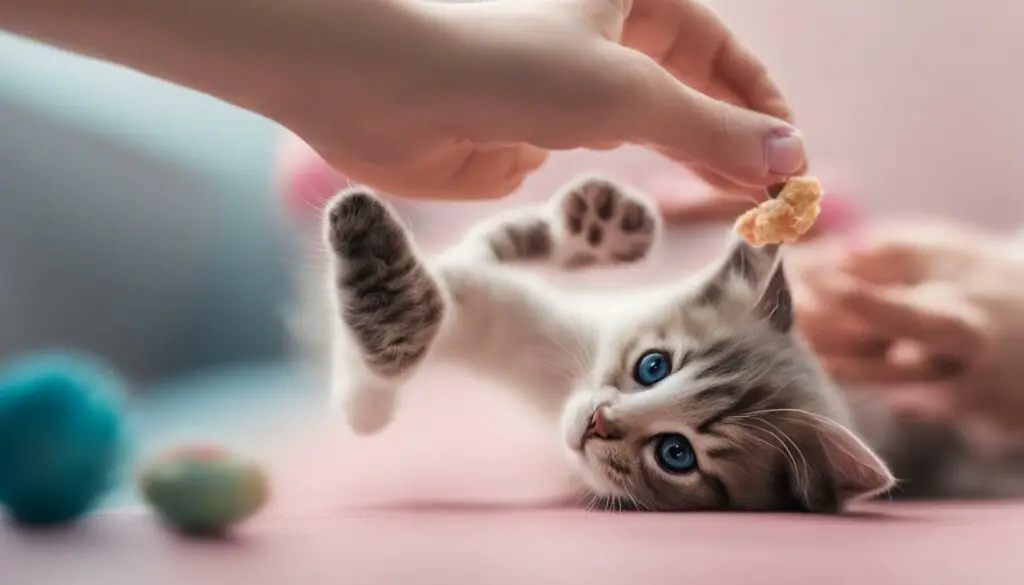
Remember, building trust takes time, so be patient and consistent in your interactions with your cat. Each cat is unique, and it may take longer for some cats to fully trust their owners. With love, patience, and understanding, you can create a bond built on mutual trust and respect.
Handling Scared Cats
Handling scared cats requires a gentle and patient approach to help them feel safe and secure. Understanding cat body language is crucial in recognizing their fear cues and responding appropriately. Cats may exhibit behaviors such as hiding, cowering, hissing, or attempting to escape when they are scared.
To handle a scared cat, it’s important to create a calm environment and approach them slowly and quietly. Avoid sudden movements or loud noises that may further frighten the cat. Offer them a safe space, such as a hiding spot or a quiet room, where they can retreat and feel secure.
Calming techniques can also be helpful in soothing a scared cat. These may include using pheromone sprays or diffusers, playing soft and calming music, or providing gentle massage and reassurance. It’s essential to respect the cat’s boundaries and not force interactions. Building trust through positive reinforcement and rewarding calm behavior can gradually help a scared cat feel more comfortable and secure in their surroundings.
| Calming Techniques for Scared Cats | Benefits |
|---|---|
| Using pheromone sprays or diffusers | These products release synthetic pheromones that mimic the natural calming scents produced by cats, helping to reduce anxiety and promote relaxation. |
| Playing soft and calming music | Gentle music with a slow tempo and soothing melodies can help create a peaceful atmosphere and promote a sense of calmness in scared cats. |
| Providing gentle massage and reassurance | Gentle strokes and comforting touch can help relax a scared cat and make them feel safe and loved. It’s important to be mindful of their comfort level and avoid any areas they may find sensitive. |
Remember, each cat is unique, and it may take time and patience to help a scared cat overcome their fears. By using calming techniques, providing a safe and secure environment, and building trust through positive experiences, you can help your scared cat feel more at ease and prevent them from running away.

Training and Preventive Measures
When it comes to preventing your cat from running away, training and proactive measures are key. By implementing the following strategies, you can help ensure your cat’s safety and minimize the desire to roam:
- Recall Training: Teaching your cat to come back when called can be a lifesaver in outdoor situations. Start in a controlled environment, using treats and positive reinforcement to encourage your cat. Gradually increase the distractions and distance as your cat becomes more comfortable with the command.
- Cat-Proofing the Home: Creating a cat-friendly and secure environment is essential. Check for any potential escape routes, such as open windows or loose screens, and address them accordingly. Ensure your cat has plenty of stimulating toys, scratching posts, and perches to satisfy their natural instincts.
- Indoor Enrichment: Cats are natural hunters, and providing mental and physical stimulation indoors can help satisfy their instincts. Consider puzzle feeders, interactive toys, and designated play areas to keep your cat engaged and entertained.
- Address Underlying Issues: If your cat’s running away behavior is caused by fear or stress, it’s important to address these underlying issues. Consult with a veterinarian or a licensed veterinary behaviorist for guidance and potential solutions.
By incorporating these training and preventive measures into your cat’s routine, you can help them feel secure and content in their environment, reducing the likelihood of them running away.

“Training and preventive measures play a crucial role in preventing your cat from running away.”
Remember, each cat is unique, and it may take time and patience to find the right approach for your furry companion. Consistency, positive reinforcement, and understanding your cat’s individual needs are essential in building a trusting relationship and preventing them from running away.
Tips for Bonding with Your Kitten
Bonding with your kitten is an essential part of establishing a strong and trusting relationship. By taking the time to understand their needs and providing positive experiences, you can create a deep bond that will last a lifetime.
1. Spend Quality Time Together
One of the best ways to bond with your kitten is to spend dedicated quality time together. This can include playing interactive games, grooming sessions, or simply snuggling up on the couch. By engaging in activities that your kitten enjoys, you can build trust and create positive associations.
2. Respect Their Boundaries
It’s important to respect your kitten’s boundaries and not force them into interactions they’re not comfortable with. Some kittens may need more time to adjust to new situations or people. By allowing your kitten to approach you on their own terms, you can build trust and create a safe and secure environment.
3. Provide Positive Experiences
Creating positive experiences for your kitten is crucial in building a strong bond. Offer treats, praise, and gentle petting when your kitten demonstrates desirable behaviors. This positive reinforcement will help your kitten associate you with reward and strengthen your bond over time.
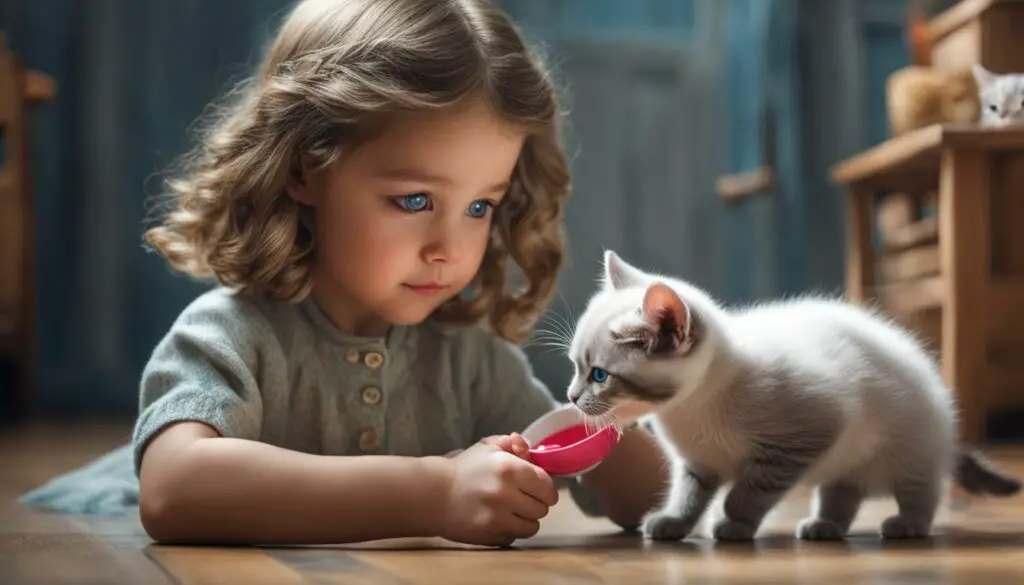
4. Understand the Importance of Kitten Socialization
Proper socialization is key to a kitten’s development and their ability to form strong bonds with humans. Expose your kitten to a variety of people, sights, and sounds in a safe and controlled manner to help them become confident and comfortable in different environments.
Remember, building a bond with your kitten takes time, patience, and understanding. By following these tips and providing a nurturing environment, you can create a deep and lasting connection with your furry friend.
Tips for Finding a Lost Kitten
If your kitten has run away and you’re feeling worried and anxious, take a deep breath and stay calm. There are several steps you can take to increase your chances of finding your lost furry friend.
- Search the immediate area: Start by thoroughly searching your home, yard, and any nearby hiding spots. Look under furniture, inside closets, and behind appliances. Use a flashlight to check dark corners or cramped spaces.
- Post lost kitten flyers: Create eye-catching flyers with a clear photo of your kitten, a brief description, and your contact information. Hang them up in your neighborhood, local stores, veterinary clinics, and animal shelters. Social media platforms and online lost pet networks can also be effective for spreading the word.
- Contact local animal shelters and veterinarians: Reach out to your local animal shelters and veterinary clinics to report your lost kitten. Provide them with a detailed description and your contact information. They may have received information about a found kitten matching your description.
- Utilize GPS or microchip tracking devices: Consider using GPS or microchip tracking devices specifically designed for pets. These devices can help you track the location of your kitten in real-time, making it easier to locate them quickly.
Remember, time is of the essence when searching for a lost kitten. Act promptly and communicate widely to increase the chances of a safe and swift reunion. Stay positive, and don’t give up hope. Your efforts and determination can make all the difference in finding your lost kitten.
| Tip | Key Points |
|---|---|
| Search the immediate area | Thoroughly check your home, yard, and nearby hiding spots |
| Post lost kitten flyers | Create flyers with a photo, description, and contact information, and distribute them in your neighborhood and online |
| Contact local animal shelters and veterinarians | Report your lost kitten to local shelters and vets; they may have received information about a found kitten |
| Utilize GPS or microchip tracking devices | Consider using technology to track your kitten’s location and increase the chances of finding them |
By following these tips and taking immediate action, you can maximize your chances of finding your lost kitten and bringing them safely back home.

Conclusion
Understanding your cat’s behavior is crucial in building a strong bond and preventing them from running away. Cats may run away due to various factors such as illness, stress, fear, lack of socialization, genetics, or mood. By addressing these issues and providing a secure and stimulating environment, you can create a trusting relationship with your kitten.
To build a strong bond with your cat, spend quality time with them, respect their boundaries, and offer positive experiences. Regular playtime, consistent interaction, and understanding their individual needs are key. Patience, consistency, and love will help foster a deep connection and mutual trust.
If your kitten does happen to run away and become lost, take immediate action. Search the area, post flyers, contact local shelters and veterinarians, and utilize online lost pet networks. Prompt action and widespread communication increase the chances of finding a lost kitten.
Remember, every cat is unique, and it’s important to adapt to their needs and preferences. By understanding your cat’s behavior, providing proper care and attention, and creating a loving and secure environment, you can ensure a happy and fulfilling relationship with your furry friend.
FAQ
Why is my kitten running away from me?
There can be several reasons why a kitten may run away, including illness or injury, stress or fear, personality traits, mood, and playfulness.
How can I stop my kitten from running away?
It’s important to address any underlying issues, such as illness or stress, and to provide a secure and stimulating environment. Positive reinforcement, training, and proper socialization can also help prevent your kitten from running away.
What should I do if my kitten is scared and running away?
Handling scared cats requires gentle and calm interactions, creating safe spaces, and using positive reinforcement. Understanding their body language and providing a calm environment can help reduce fear and anxiety.
How can I bond with my kitten?
Spending quality time together, respecting their boundaries, and providing positive experiences can help build a strong bond with your kitten. Regular playtime, consistent interaction, and understanding their individual needs are key.
What should I do if my kitten is lost?
Take immediate action by searching the immediate area, posting lost kitten flyers, contacting local animal shelters and veterinarians, using online lost pet networks, and considering the use of GPS or microchip tracking devices. Prompt communication and widespread search efforts increase the chances of finding your lost kitten.
Why do cats run away from their owners?
Cats may run away due to illness or injury, stress or fear, personality traits, mood, or simply as part of their playfulness. Understanding these factors can help address and manage their behavior.
What are the signs of illness in cats?
Cats are masters at hiding signs of illness, but if your cat starts running away or avoiding you, it may be a sign of an underlying health issue. Other signs of illness can include changes in appetite, litter box habits, energy levels, and grooming patterns.
How can I reduce stress and fear in my cat?
Identifying and removing the source of stress or fear, creating a calm and secure environment, and consulting with a veterinarian or a licensed veterinary behaviorist can help reduce stress and fear in cats. Calming techniques, such as pheromone diffusers or supplements, may also be beneficial.
Can a cat’s personality affect their tendency to run away?
Yes, each cat has its own unique personality, preferences, and social interaction needs. Some cats may enjoy frequent and intense social interactions, while others prefer shorter or lower-intensity interactions. Respecting their individual needs can help prevent them from running away.
Why does my cat run away during playtime?
Running away during play can be part of a cat’s playful behavior. If your cat seems happy, relaxed, and initiates play repeatedly, it may indicate that they are engaging in playful behavior. Providing ample outlets for their climbing and exploratory instincts can reduce their desire to run away during playtime.
How does lack of socialization affect a kitten’s behavior?
Lack of socialization during the critical period of a kitten’s life, around 3-7 weeks of age, can contribute to fearfulness and running away behavior. Proper socialization with a variety of people can help kittens become more friendly and comfortable with human interactions.
Can genetics and temperament impact a cat’s tendency to run away?
Yes, cats born to stressed mothers or in stressful environments may exhibit more fear and anxiety as they grow up. Understanding a cat’s genetic predisposition and temperament can help in managing their behavior and forming a trusting relationship.
How can I build trust with my cat?
Building trust with a cat requires consistency, understanding their boundaries, and providing positive experiences. Respecting their limits, offering safe spaces, and using positive reinforcement can help gain a cat’s trust. Patience, consistency, and love are essential in creating a trusting relationship.
What should I do if my kitten is scared and running away?
Handling scared cats requires gentle and calm interactions, providing safe spaces, and using positive reinforcement. Learning to read their body language and creating a calm and secure environment can help prevent them from running away.
How can I prevent my cat from running away?
Training a cat, implementing preventive measures, and creating a secure environment can help prevent them from running away. Recall training, cat-proofing the home, and providing stimulating environments are important steps in keeping cats safe and reducing their desire to run away.
How can I strengthen the bond with my kitten?
Spending quality time together, respecting their boundaries, and providing positive experiences can help build a strong bond with your kitten. Regular playtime, consistent interaction, and understanding their individual needs are key in strengthening the bond.
What should I do if my kitten is lost?
Take immediate action by searching the immediate area, posting lost kitten flyers, contacting local animal shelters and veterinarians, using online lost pet networks, and considering the use of GPS or microchip tracking devices. Prompt communication and widespread search efforts increase the chances of finding your lost kitten.
Source Links
- https://catanddoghouse.com/why-does-cat-run-away-from-me/
- https://cats.com/why-does-my-cat-run-away-from-me
- https://tractive.com/blog/en/good-to-know/why-your-cat-is-running-away

